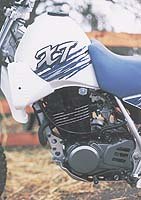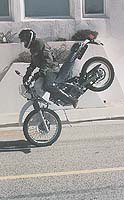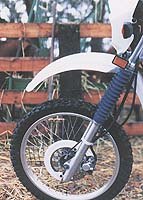|
Motorcycle News - Church of MO: 1998 Yamaha XT350
https://ift.tt/2IIV7Wt  What has been will be again, what has been done will be done again; there is nothing new under the sun. And Yamaha will still sell you a brand-new XT250 for a mere $750 more than this twenty-year old XT350. First Impression: 1998 Yamaha XT350A Tale of Two XTs
By Kerry Ward, Contributing Writer Feb. 20, 1998
Let’s get one thing straight. Even though the first bike I tested pulled a full-on Chernobyl, I liked the XT. So, we’ll deal with the unpleasantries first and then move into the meat of the test. Consider it a bad news first type of situation, if you will, so we can finish on a happy note.
Let’s set the scene. It was the middle of a dark and stormy night, cold, black and miserable. There I was, tooling along at 70 miles per hour on the Grapevine (I-5 north of Bakersfield). XT350 number one decides to give in to the dark side of the Force and pull a Mr. Hyde on me. What does this hideous transformation look like? Well, it’s dark, so all I know is the bike lost power dramatically. Hmmmmm, I think to myself, this is not good (a keen deduction). I pull in the clutch to see if the motor will die or idle. It dies.  Ordinarily, this wouldn’t be a big deal, but since there isn’t a proper electrical system on this bike, there is a problem; the headlight turns off when the motor stops turning. Now, coasting along a freeway in the black of night at 70 mph isn’t a problem if one’s eyes are adjusted. Mine weren’t. I let out the clutch again to get the mortally wounded motor spinning again so I could light the way and pull over to the shoulder. With the aid of the ambient light from the odd passing car, I see the Yamaha motor smoking. Mr. Hyde has made his ugly appearance. The expired bike’s odometer reads 800 miles. This is well past the 600 miles recommended for proper break in, even if I haven’t paid a lick of attention to the procedure. On this day, though I’ve already come 300 miles, I’ve got another hundred or so to go before I’m home. I survey the countryside surrounding me and determine my exact location. There is a distinct lack of landmarks, absolutely none whatsoever. There is nothing but empty space. I spend the next forty-five minutes trying to flag cars down out of the night, praying for a kindly driver with a cell phone to come to my rescue. But alas, I am a scary biker and dressed the part. It doesn’t happen. I start walking hoping to find a highway call-box somewhere in the murky gloom. Half a mile away from my bike I look back to see a vehicle pulled to the shoulder next to the bike.
It turns out to be a big ole’ extend-a-cab Ford F-250 pickup truck. The guy behind the wheel tells me he usually doesn’t pull over to help people, but since he saw me walking, then saw my bike, and he is a fellow rider (who else would stop?), he thought he’d break this habit and offer a hand. He asks me if I’m headed anywhere near Redondo Beach. As a matter of fact, I live within 10 miles of the place. Perfect, we load up the bike (he even has tie downs!) and off we go, on a 100 mile jaunt. He drops me at my pad, bike and all. I wish getting home after every breakdown could be so easy. Now, I needed to break the news to Yamaha: Their machine was dead. It perished in my hands. Yamaha, bless their souls, took the bike back and swapped it for a new one for the sake of this story. Subsequent questioning about the status of the Mr. Hyde XT revealed that the bike had suffered an oil pump failure. An oil light would be nice. That was the bad news. Yamaha has made this bike for more than a decade and they tell me they had never heard of this kind of failure. In fact, when I first told them the motor had let go, they were rather shocked. The XT350 motor has a reputation for being bulletproof.
So, having panned the first bike, let’s discuss the merits of the next machine, a Dr. Jeckyl to the Mr. Hyde XT. The XT is surprisingly good on the highway. Riding position is upright, but wind is somewhat deflected by the G-string faring (the fairing is too small to be called even a bikini fairing). Body position somewhat counteracts the wind as well and makes the XT more tolerable for disposing mileage than many cruisers, which force a rider to adopt the dreaded flying squirrel posture. Cruising speed is on the moderate side, though the motor willingly spins up close to redline in sixth gear, good for maintaining speeds in the 75 miles per hour range. With a tailwind, 90 mph is possible, but it would be positively rotten to maintain this speed for any time. The mirrors work well, offering a vibration-free picture without including any elbows in the vision equation. For extended highway trips the seat is on the narrow side, but adjusting body position by moving forward and back allows extended saddle time. My longest day thus far on the bike has been 500 miles. And I could walk afterwards. Longer stints are definitely possible. If you are looking to buy a machine to actually ride to an ORV area, the XT would be perfect.  In the off-road department, the XT functions adequately, but it isn’t motocrosser. Jeremy McGrath wouldn’t be winning any Supercross events on this particular Yamaha, even though it sports 100cc’s more displacement than his usual Yamaha. Landing a triple on the softly sprung suspension would be plain heinous, too. As a matter of fact, landing even moderate jumps on the XT had the rear end bottoming out and the tire hitting the underside of the fender. Air? Yes please. Big air? No thank you. No Crusty Demons highlights for this bike. Seth need not bother.  The suspension lacks the progressive dampening required for handling gnarly off-road excursions. But the XT is a fairly upright bike and handling is nimble in the dirt. This is the perfect bike for rambling around fire roads and exploring the odd ORV trail. Slap some knobbies on the beast and off-roading will be much more palatable. With 10 inches of travel on the front forks and more than eight with the rear mono-shock, there is plenty of room for tweaking. The rear shock is adjustable with preload and damping tuning possible; it has an adjusting knob for changing the damping, while preload can be adjusted via a threaded collar. If you plan on using your XT mostly on the trails, a call to an aftermarket suspension company would be in order. Air scoops look cool. Who needs function? This would be the second investment to make after tires. You might just make the bike into a PDG (pretty darn good) dirt bike.  The XT conquered every obstacle in our rigorous, multi- million dollar, off-road testing facility in a most mundane manner. The XT conquered every obstacle in our rigorous, multi- million dollar, off-road testing facility in a most mundane manner.
The shock on the rear has an adjusting knob for changing the damping and preload can be adjusted via a threaded collar. There are a number of nice features on the XT. Snail-cam adjusters reside on either side of the rear axle, so chain adjustment is a snap. The engine has a counterbalancer, which leads to an extremely smooth-spinning motor. There are also passenger pegs on the bike. (I found these were good for resting my legs on long trips.) Be forewarned, however, taking a passenger isn’t the most comfy of propositions. I found myself having to sit farther forward on the saddle than my manhood and I would have preferred. Also, with two full-sized people onboard, there is an excessive amount of sag on the rear end. It is a good bike for many different weather conditions, though. In inclement weather, the XT shines. The heavily treaded tires yield good, wet grip for stopping, cornering, and acceleration. Maneuverability is especially good with the wide handlebars offering easy leverage and instilling confidence. This trait serves well on both the trail and in the urban jungle. Lane splitting on the XT is easy with its upright seating giving a good view of traffic.  350 cc’s of pure badness. Is that good? It depends. 350 cc’s of pure badness. Is that good? It depends.
Starting duties on the kick start XT can be a challenge, but once mastered, it’s smooth. Simply leave the bike on the kickstand so you can get a better kick, stand on the pegs and give’er what’fer. Once it starts, let it idle for a few moments then be sure to retract the kickstand. It kills the motor if you put the machine in gear with the kickstand down. When cold, the bike likes some choke; when hot, it takes none. The gray area of the starting equation comes when the bike is actually warm, having been ridden within the past few hours, or stopped/stalled before reaching full operating temperature. This no- man’s-land can lead to frustration and a whupped kicking leg. Faith and persistence will carry the day. Good luck.  The XT can be great fun to ride. Even though it feels like it falls into corners, the handling characteristics encourage the rider to throw the bike around. It is nimble and predictable. The seat height is perfect for me (at 6 feet 1 inch). I have no problems putting both heels on the ground straddling the bike at a standstill. The XT has about the lowest seat height in its class, though those with shorter inseams will be on tiptoe at stoplights. The brakes work quite well, but expect to use the surprisingly effective rear brake more than you might be used to. Stepping on the rear brake pedal has the added benefit of reducing dive, which plagues the front end of the bike, something not unexpected on a bike with nearly a foot of travel on the front fork. The first time I tried to use the steering lock on both test bikes, I was flummoxed. The lock is so stiff and awkward to engage, I thought the machine didn’t have a lock, despite the ignition barrel indicating otherwise. Warning: It takes much jiggering and shaking to engage the neck-mounted locking mechanism. You’d figure after manufacturing the same bike for more than a decade these details might be ironed out.Let’s give Yamaha the benefit of the doubt and chalk up the unfortunate demise of our first test unit as an anomaly. For the record, yes, the first XT went Mr. Hyde and had a meltdown. But this second bike has been such a kick to ride, I’m willing to forgive and forget. This is a machine any beginner could learn to ride without worrying about breaking the bank repairing damage from simple tipovers. This is a machine any dual sporter could happily ride to the ORV area for a day of pummeling the mud.  Actual knobby tires would make all the difference in the gnarly goop. Slick conditions will see you skating around the mud spinning the rear tire at will – even with the chugging 350 motor. If you plan on riding this bike mostly off road, spring for full-knobs. Actual knobby tires would make all the difference in the gnarly goop. Slick conditions will see you skating around the mud spinning the rear tire at will – even with the chugging 350 motor. If you plan on riding this bike mostly off road, spring for full-knobs.
This is a machine abord which any urban assault warrior could conquer the meanest pothole-ridden battlefield. I love being able to ramp off curbs and over parking stops with impunity. I love being able to shift through the gears on one wheel – and still keep to a reasonable speed. I love being able to steer off of the beaten path and feel confident navigating rough and tumble trails. The XT350 is good fun. At first, I was ready to lambasted this bike; but since I have had an opportunity to re-evaluate my evaluation, I’ve changed my tune. I want one. Specifications: Yamaha XT350 Price: $4449 346cc air-cooled four-valve four-stroke 86 x 59.6mm bore & stroke 9:1 compression ratio 24mm Teikei carburetor 6-speed transmission 33.7" seat height 88.2" x 34.1" x 47.6" (overall length x width x height) 55.9" wheelbase 10.8" ground clearance Fuel Capacity: 3.2 gallons (including 0.5 gallon reserve) Telescopic forks, 10" of travel Single rear shock, 8.6" of travel 3.00-21 front tire 110/80-18 rear tire 262 pound dry weight The post Church of MO: 1998 Yamaha XT350 appeared first on Motorcycle.com. Motorcycles via Motorcycle.comMotorcycle.com https://ift.tt/Xzx9iy July 1, 2018 at 11:50AM Leave a Reply. |
�
Categories
All
Archives
November 2020
|



 Not a whole lot has changed on this bike in 13 years. This 86′ XT, stripped of street gear for dirt duty, is pretty much identical to the 97′ bike we tested. Yamaha hasn’t broken the bank improving this model.
Not a whole lot has changed on this bike in 13 years. This 86′ XT, stripped of street gear for dirt duty, is pretty much identical to the 97′ bike we tested. Yamaha hasn’t broken the bank improving this model.
 Great instrument cluster. Too bad there’s no oil light.
Great instrument cluster. Too bad there’s no oil light.


 Gracing the rear fender is a little pouch containing the Yamaha tool kit. You could fit a kit of your own inside, as long as it was the size of a Kit Kat. Anything else would probably be too big to fit.
Gracing the rear fender is a little pouch containing the Yamaha tool kit. You could fit a kit of your own inside, as long as it was the size of a Kit Kat. Anything else would probably be too big to fit.
 The front binder isn’t the most sensitive unit on the planet. Generous suspension, with swoopy accordion-style fork tube protectors, dives under heavy braking.
The front binder isn’t the most sensitive unit on the planet. Generous suspension, with swoopy accordion-style fork tube protectors, dives under heavy braking.
 RSS Feed
RSS Feed

7/1/2018
0 Comments